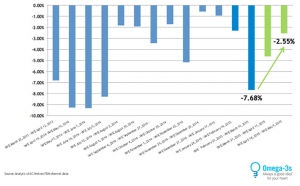SymphonyIRI Group continues its analysis of the CPG industry’s performance throughout the past year and identifies new market opportunities in its latest report, “Times & Trends: CPG 2010 Year in Review: Out of Turmoil Rises Opportunity.”
“Although many are breathing a sigh of relief since the “Great Recession” officially ended in mid-2010, other consumers are still on the fence and wondering if it’s a bit premature,” said John McIndoe, senior vice president, Marketing, SymphonyIRI. “Make no mistake, the CPG industry will continue to serve a very conservative consumer base in 2011. Nonetheless, this is a time of great opportunity for marketers. The key is to act with a clear and precise understanding of the changing attitudes, needs and behaviors of your most important shoppers and target segments.”
CPG growth is being influenced by a number of factors, such as home-based eating and drinking and self-reliant health and beauty care rituals. Above average unit sales growth of 1.6% across the center store department illustrates the power of these rituals. This department is home to several of the fastest growing categories of 2010, including ready-to-drink coffee/tea, energy drinks and sports drinks. While average beauty/personal care department unit sales lagged industry average by a small amount, growing 0.8%, dollar sales grew more quickly than the industry average at 2.2%, largely driven by innovation that enticed consumers to trade up in key categories, such as eye and facial cosmetics.
Energy drinks led the way across the top 10 CPG categories, with 13.5% unit sales growth in 2010. This category received a significant boost from energy shot sales in the convenience channel. The wine category grew by 5.7%, followed by chocolate candy at 4.9%, salty snacks at 2.9% and bottled water at 2.7%. On the other end of the spectrum, milk category unit sales slid by 3% in 2010.
Last year also marked the return of inflationary trends, with food prices increasing by an average of 0.5-1.5% for the year. Some categories saw rather substantial price increases, with sugar leading the way at 12.5% followed by butter at 8.7% and breakfast meats at 8.6%. On average, though, packaged goods prices slid in 2010, down an average 1% versus 2009. Many of the price cuts last year were the result of high promotional activity. Pricing trends are likely to shift in 2011, with food-at-home prices expected to climb by 2-3%.
“More than ever, it is critical for CPG marketers to heighten their understanding of the nuances behind today’s trends and then communicate with shoppers on a very intimate level by complementing traditional online and print marketing strategies with new communication mediums, such as social media and smart phones/mobile devices,” added Mr. McIndoe. “In doing so, savvy marketers will achieve new heights in dollar and unit share uplift, while fortifying relationships with an ever-increasing number of shoppers.”
To effectively compete in an unpredictable economy, SymphonyIRI recommends that CPG and retail companies should consider the following action items:
• Identify discreet microsegments
• Target opportunities and risks of serving each
• Evaluate pricing, promotion and merchandising strategies
• Explore opportunities to enhance product assortment
• Create new strategies for collaboration throughout the entire value chain























